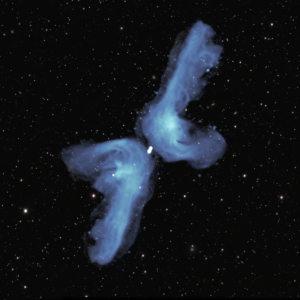In the past century, black holes have transformed from being a mere curiosity into a key element of modern…


Double Boomerang
This new image of galaxy PKS 2014-55, located 800 million light years from Earth, was made by NRAO scientist William Cotton with the South African Radio Astronomy Observatory (SARAO) MeerKAT telescope. It shows for the first time how the galaxy’s X-shape is actually a ‘double boomerang’. Two powerful jets of radio waves, indicated in blue color, originate from a massive black hole at the center of the galaxy. They each extend 2.5 million light years into space (comparable to the distance between the Milky Way and the Andromeda galaxy, our nearest major neighbour). Eventually, the jets are ‘turned back’ by the pressure of tenuous intergalactic gas. As they flow back towards the central galaxy, they are deflected by its relatively high gas pressure into the shorter, horizontal arms of the boomerang. The background image shows visible light from myriad galaxies in the distant universe.

EHT image of quasar 3C 279
The Event Horizon Telescope observed the finest detail ever seen in a jet produced by a supermassive black hole. Quasar 3C 279 contains a black hole about one billion times more massive than our Sun. Twin fire-hose-like jets of plasma erupt from the black hole and disk system at velocities close to the speed of light: a consequence of the enormous forces unleashed as matter descends into the black hole’s immense gravity.





